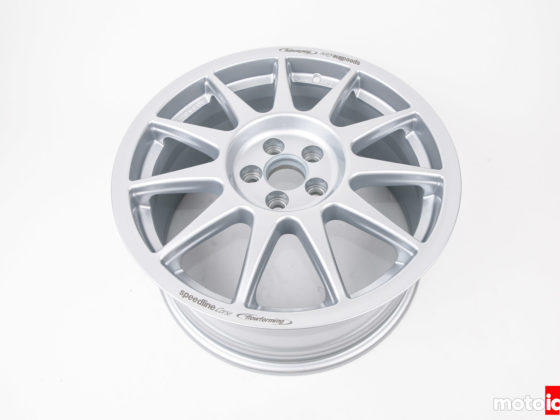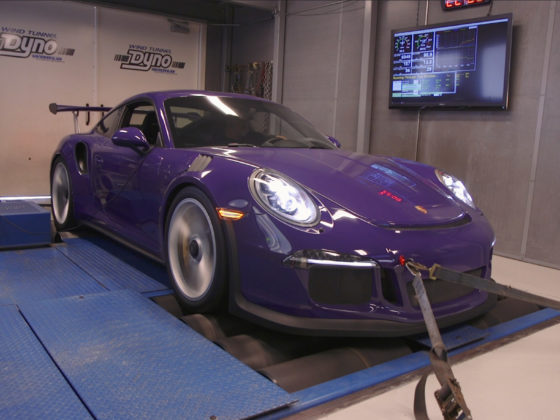
Mazda created this little outdoor handling course for us to test out the i-ACTIV AWD system. It consisted of an initial 180-degree turn followed by a short acceleration section, into a slalom, followed by another 180 degree left into a bit of a bus stop chicane.

I have to say, it was actually a little disappointing how good the i-ACTIV AWD system behaves. I was trying to use my lessons learned at Rally Ready Driving School to get sideways. But, the CX-5 with the snow tires, i-ACTIV AWD, and its Dynamic Stability Control system actually exhibited tremendous traction and stability. This was my first time driving in snow but it felt roughly like driving in hard-packed dirt as far as traction goes. The CX-5 DOES allow some left-foot braking with throttle overlap which is a technique used in rally driving. Perhaps we can thank Dave for that as he raced rally back in the day. So yes, you can left-foot brake while staying on the throttle to a certain degree. If you use too much left-foot brake pressure, it will shut down the party as I found out going through the second 180 degree turn on one of my runs. The Dynamics Stability Control and Traction Control Systems are tuned to allow for some tire spin and vehicle slide before the systems kick in. So, the driver can have some fun. However, once the car does get too far out of control the DSC kicks in with a none-too-subtle interruption to say, “yes, you went too far”. The reasoning that Mazda used for a relatively abrupt intervention was to clearly let the driver know they exceeded the allowable conditions. If the system were too subtle, then the driver could possibly enter into a situation that was beyond the capability of the system to correct. For the TCS, it’s actually worse to turn it off rather than leaving it on. Turning TCS off was designed to help get the car un-stuck out of muddy situations and not for hooning. So, when the car detects wheel spin with TCS off, it will brake the spinning wheel to transfer torque to the wheel with traction whereas leaving TCS on will allow for wheelspin. In short, for maximum fun, leave TCS on.

The i-ACTIV AWD uses a slip prediction algorithm so that it can predict instead of just reacting to limited traction conditions. Being able to predict reduces the response time creating better performance. So instead of old-school systems which look at only wheel speed differences, Mazda predicts the surface conditions using inputs such as temperature, windshield wiper, and slope. If it’s cold and/or the driver has the wipers going, it’s probably going to be slippery. If the car is on an uphill slope, the front tires will be more likely to slip, so it’s an easy prediction to transfer the power to the torque to the rear wheels which is done through an electromagnetically actuated torque coupling. Mazda uses steering effort and wheel speed too of course. There’s not a whole lot to say about the CX-5 in the snow aside from it just goes. For some video of driving in the snow course, check out the review on Youtube from Redline Reviews and fast forward to 22:58 mark.

The all-weather floor mats doing their thing.

The new CX-5 with the SKYACTIV-G 2.5T engine is really fun to drive. You can tell it was developed by a team of people who enjoy driving. The turbo engine has essentially eliminated perceptible turbo lag by Mazda using their unique design. In everyday driving, it just accelerates effortlessly with torque following throttle position. The vehicle reaction to steering input is immediate thanks to GVC+ and I personally like the weight to the steering too which is a bit heavier than say Nissan or Toyota.
The details like the manual shift pattern, brake/throttle overlap capability, and DSC/TCS calibration let you know the CX-5 was tuned by guys who like to drive. Zoom-zoom indeed. We were quite impressed with the new CX-5 and found it a joy to drive compared to other vehicles in its segment. In fact, the only downside to experiencing the CX-5 and the wonderful trip is now my wife wants to upgrade her 2016 to the newer version!




7 comments
The driving force graph makes no sense.
F=ma
Not F=m
Probably marketing person just mislabeling what should be kgf. Which I need to fix myself… will edit. Thanks for the catch.
Looking at the graph a little more closely now, looks like about 75kgf to maintain speed and 325kgf to have desired acceleration. So 250kgf is about 2450N going towards acceleration and a vehicle mass of 1750kg. Works out to about 1.4 m/s^2. 1.4 m/s = 3.13mph. So…. increase almost 10mph in 3 seconds. Seems like a reasonable acceleration rate for this passing scenario.
Thanks for the clarification.
Why Mazda didn’t take full advantage of their ‘dyanamic pressure turbo’ system by squeezing out more top end power without sacrificing low end torque and causing turbo lag?
They would have to go to a bigger turbo to get more power on the top-end. That would not allow them to meet their torque target at 2000rpm where they are focused on driveability because that’s where their users spend like 97% of their time.
Ok I see, I just wish they have a more performance orientated option as well.
Does the low end and mid range performance feel more like a big, torquey naturally aspirated engine than a typical turbocharged engine?
Funny thing about that stability control: I noticed that my 2018 Mazda MX-5 GT will quite happily do donuts, which isn’t quite possible with an open differential. Sure enough, the tail end only whips out once a light on the dashboard starts blinking: the ABS is transferring the torque to the opposite wheel, even though stability control is off, in order to facilitate irresponsible driving.
Also, since I couldn’t find it on paper anywhere: the headlamps turn to see around corners, though mine inexplicably lacks the levelling system.